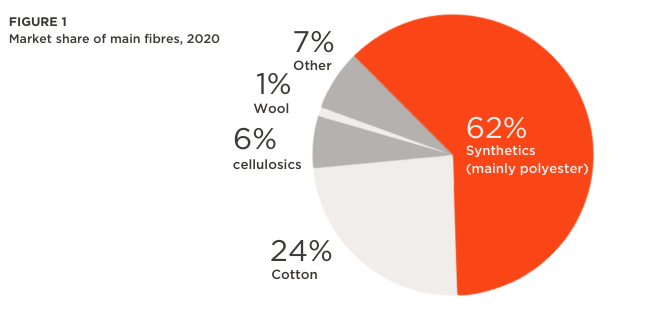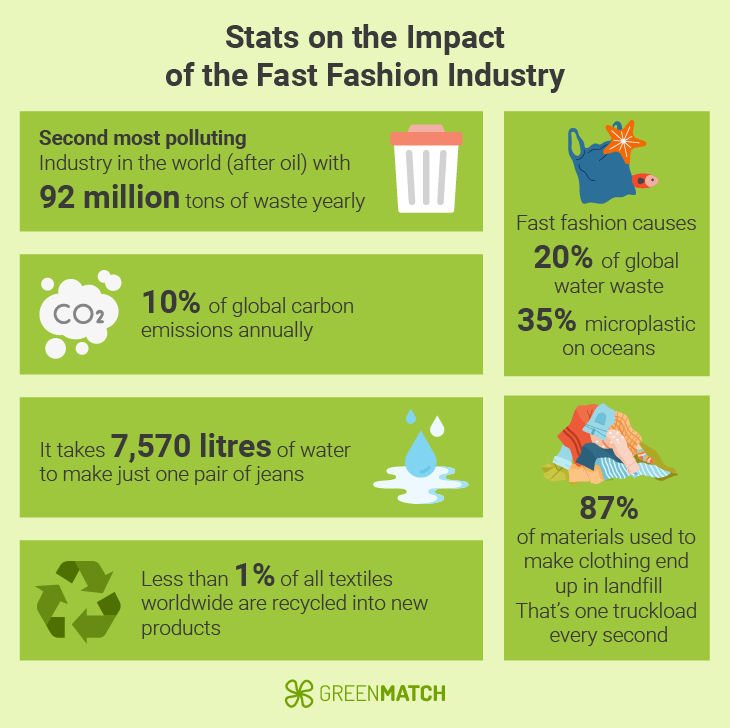Understanding Fast Fashion: The Materials Behind the Trend
Fast fashion has become a dominant model in the clothing industry, characterized by its rapid production cycles and low prices. This modern approach facilitates quick access to the latest styles, yet it raises significant environmental and ethical concerns. To comprehend the impact of fast fashion fully, one must explore the materials that underpin this industry.

Infographic showing the statistics of clothing materials used in the fashion industry.
Source: Common Objective
Materials in fast fashion are often cheap and mass-produced, leading to severe environmental degradation. Common materials used include synthetic fibers like polyester, which is derived from petrochemicals. This dependence on fossil fuels not only contributes to climate change but also results in microplastics entering our waterways and oceans.

Visual representation of the environmental impact of fast fashion.
Source: GreenMatch
According to various studies, the textile industry is the second-largest polluter globally, trailing only the oil industry. Water consumption is another critical issue; the production of cotton, a common natural fiber, is known to consume huge amounts of water, often in areas already suffering water scarcity. A staggering amount of water is used to grow the cotton that goes into fast fashion, which can lead to depletion of local water sources.
Moreover, the issue of waste cannot be overlooked. Fast fashion encourages a cycle of overconsumption, where consumers repeatedly buy and discard garments. It is estimated that each year, millions of tons of clothing end up in landfills, contributing to a significant waste problem. The short lifespan of fast fashion garments means that they are often discarded after just a few wears, resulting in an alarming increase in textile waste.

Infographic showing the impact of fast fashion on the environment.
Source: State of Matter Apparel
The rise of synthetic materials in the fashion industry poses a multitude of problems, notably concerning their biodegradability. Unlike natural fibers, which may decompose over time, synthetic fibers can take hundreds of years to break down, contributing to long-term environmental damage. Alternatives are being sought, with more sustainable practices and materials gaining traction. Organic cotton, linen, and hemp are being explored as eco-friendlier options, as they often require less water and fewer pesticides.
Initiatives to improve the sustainability of the fashion industry have gained momentum. Many brands are now focusing on their sourcing strategies and considering the entire lifecycle of their products. The shift towards circular fashion is an example of this trend, where companies design products with durability and recyclability in mind, thereby reducing waste.

Infographic detailing statistics about recycling in the fashion industry.
Source: SANVT
Furthermore, consumer awareness plays a crucial role in the industry’s transformation. As more individuals become conscious of the ethical and environmental implications of fast fashion, demand for sustainable and ethically produced clothing is increasing. This change in consumer behavior is prompting brands to reevaluate their strategies and prioritize sustainable materials and practices.
In conclusion, while fast fashion provides accessibility and affordability, the materials utilized and the resulting environmental effects raise serious concerns. The industry must transition toward more sustainable practices, utilizing environmentally friendly materials and reducing waste to protect our planet for future generations. Consumer support for sustainable practices can drive this change, fostering an industry that respects both the environment and the people involved in the production process.